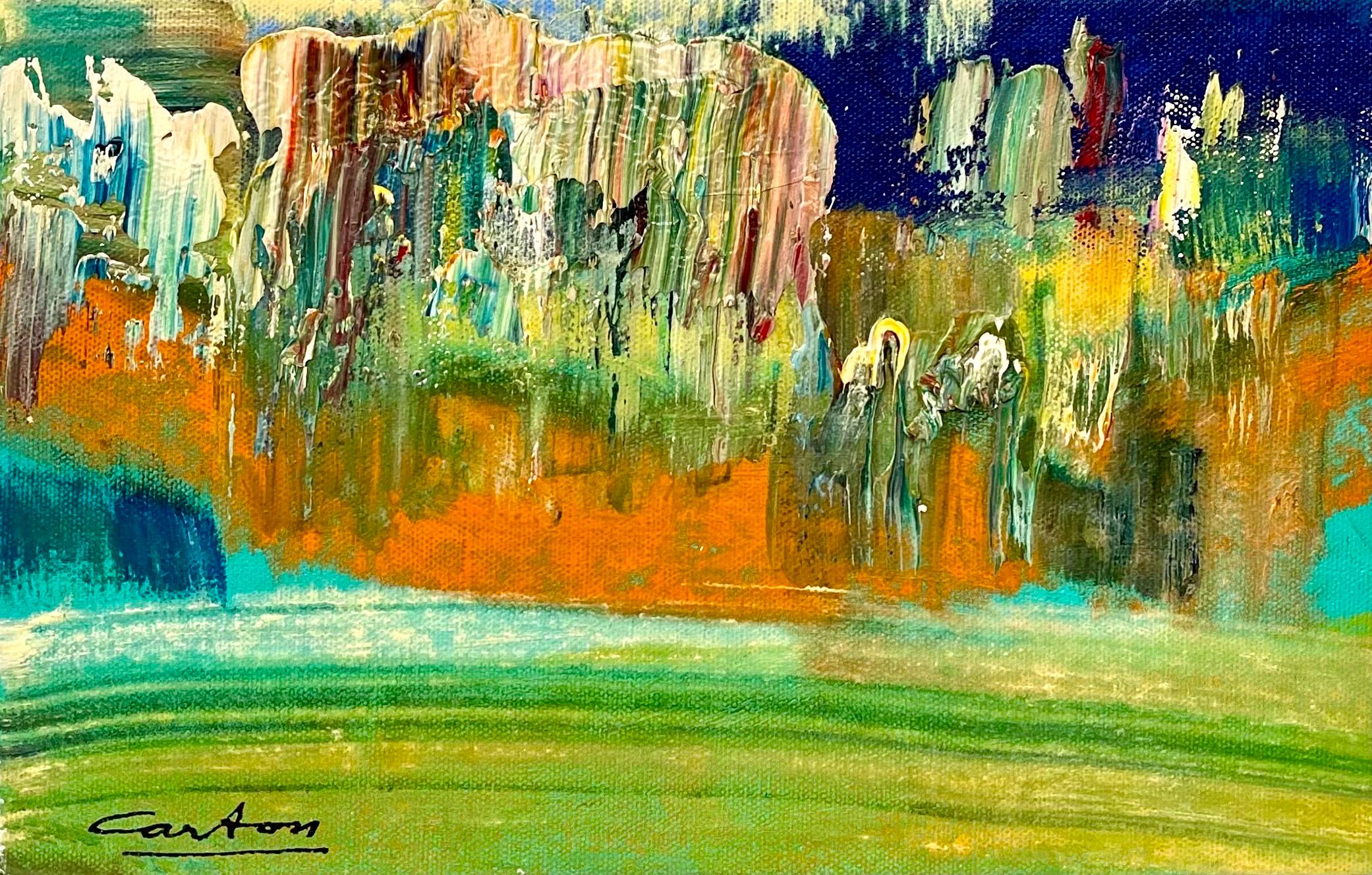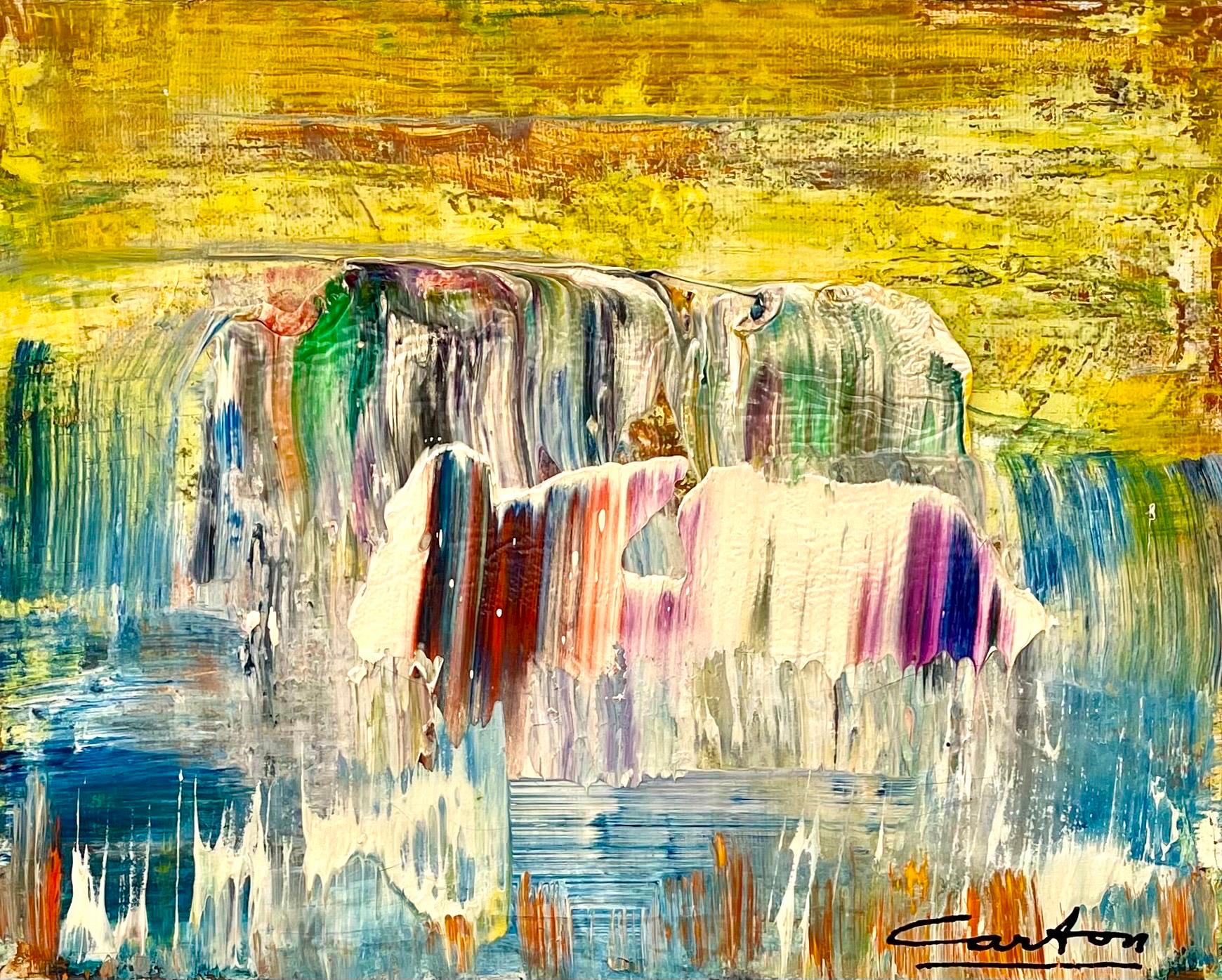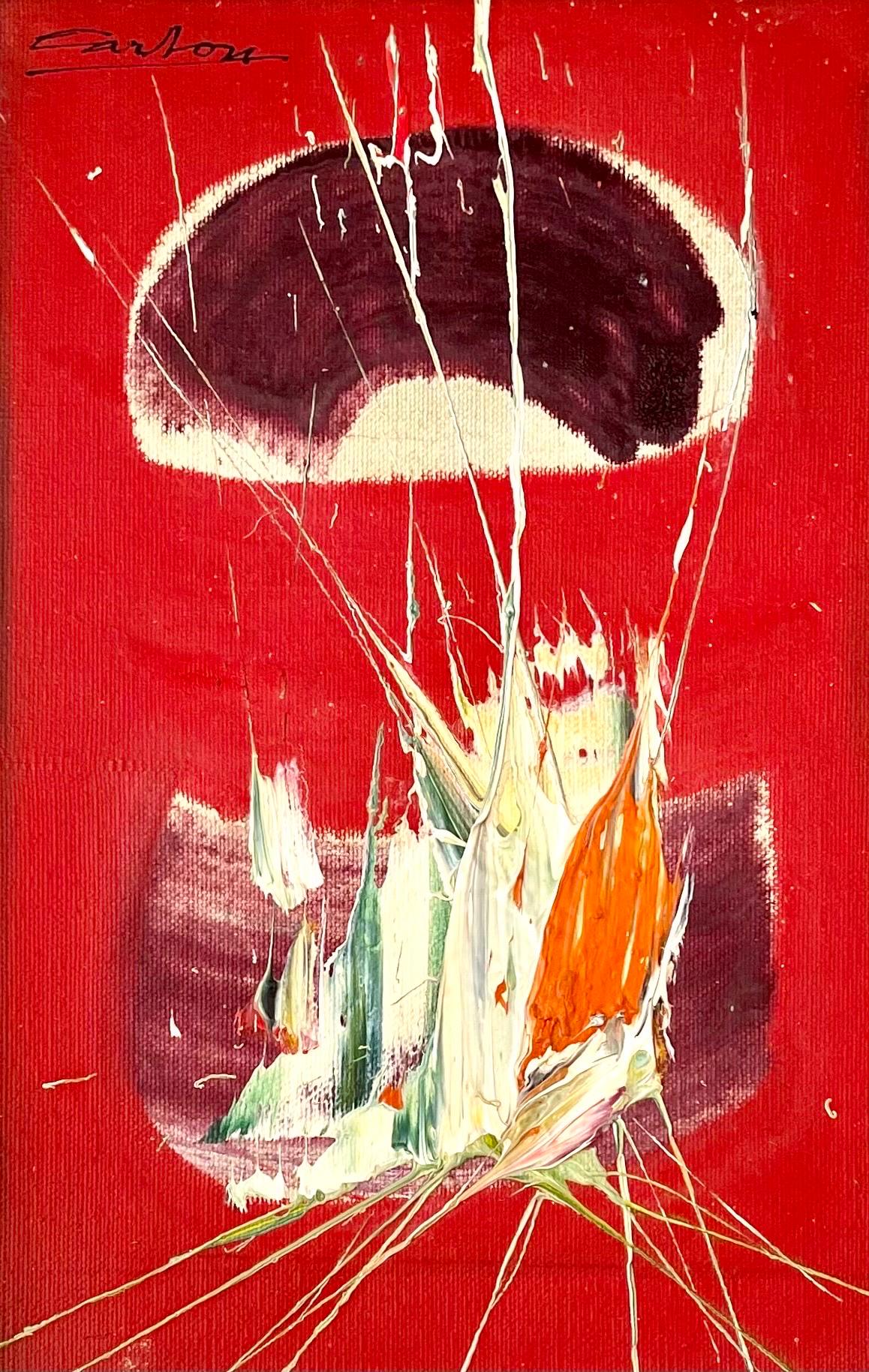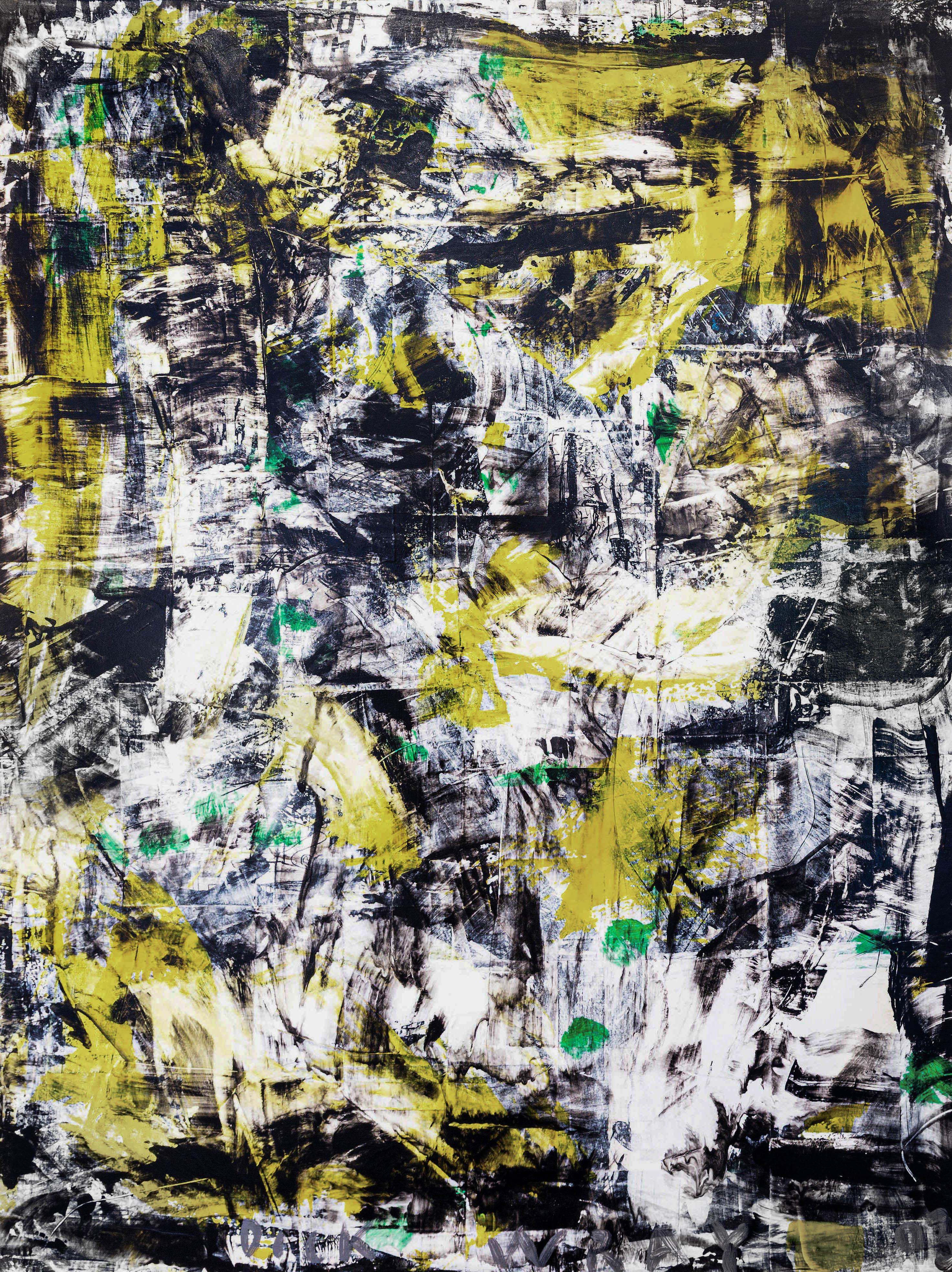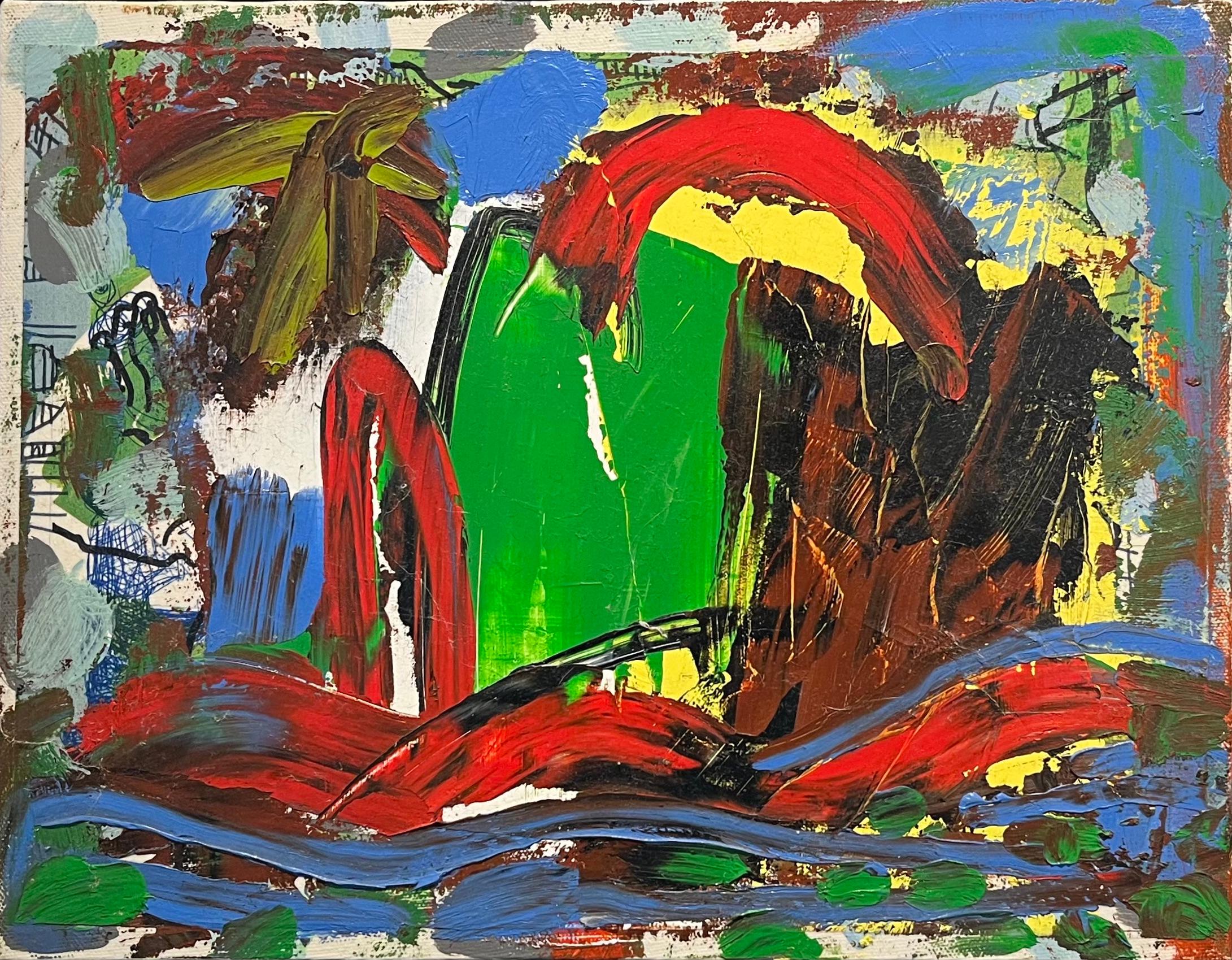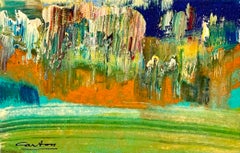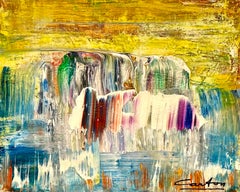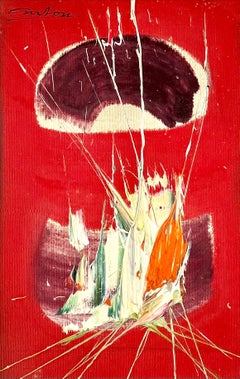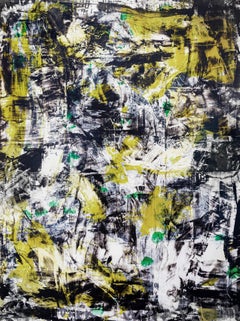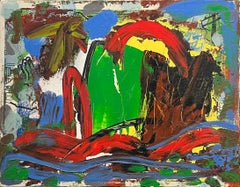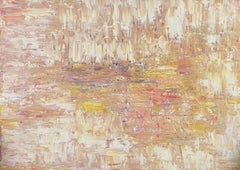Items Similar to American Vivid Abstract Expressionist Art Oil Painting Norman Carton, WPA Artist
Want more images or videos?
Request additional images or videos from the seller
1 of 8
Norman CartonAmerican Vivid Abstract Expressionist Art Oil Painting Norman Carton, WPA Artist
$2,800
£2,126.11
€2,431.36
CA$3,912.01
A$4,351
CHF 2,271.96
MX$52,947.10
NOK 29,016.39
SEK 27,212.25
DKK 18,146.18
Shipping
Retrieving quote...The 1stDibs Promise:
Authenticity Guarantee,
Money-Back Guarantee,
24-Hour Cancellation
About the Item
Norman Carton (1908 – 1980) was an American artist and educator known for abstract expressionist art. He was born in the Ukraine region of Imperial Russia and moved to the United States in 1922 where he spent most of his adult life.
A classically trained portrait and landscape artist, Carton also worked as a drafter, newspaper illustrator, muralist, theater set designer, photographer, and fabric designer and spent most of his mature life as an art educator. Carton showed in and continues to be shown in many solo and group exhibitions. His work is included in numerous museums and private collections throughout the world.
Norman Carton was born in the Dnieper Ukraine territory of the Russian Empire in 1908. Escaping the turbulence of civil war massacres, he settled in Philadelphia in 1922 after years of constant flight. While attending the Pennsylvania Museum School of Industrial Art, Carton worked as a newspaper artist for the Philadelphia Record from 1928 to 1930 in the company of other illustrator/artists who had founded the Ashcan School, the beginnings of modern American art. From 1930 to 1935, he studied at the Pennsylvania Academy of Fine Arts under Henry McCarter, who was a pupil of Toulouse-Lautrec, Puvis de Chavanne, and Thomas Eakins. Arthur Carles, especially with his sense of color, and the architect John Harbison also provided tutelage and inspiration. Following his time at the Pennsylvania Academy of Fine Arts, Carton studied at the Barnes Foundation from 1935 to 1936 where he was influenced by an intellectual climate led by visiting lecturers John Dewey and Bertrand Russell as well as daily access to Albert C. Barnes and his art collection.
Carton was awarded the Cresson Traveling Scholarship in 1934 which allowed him to travel through Europe and study in Paris. There he expanded his artistic horizons with influences stemming from Henri Matisse, Pablo Picasso, Chaim Soutine, and Wassily Kandinsky. While at the Pennsylvania Academy of Fine Arts, Carton was also awarded the Toppan Prize for figure painting as well as the Thouron Composition Prize. He received numerous commissions as a portrait artist, social realist, sculptor, and theatrical stage designer as well as academic scholarships. During this time, Carton worked as a scenery designer at Sparks Scenic Studios, a drafter at the Philadelphia Enameling Works, and a fine art lithographer.
From 1939 to 1942, the Works Progress Administration (WPA) Federal Art Project employed Carton as a muralist and easel artist. He collaborated with architect George Howe. The WPA commissioned Carton to paint major murals at the Helen Fleischer Vocational School for Girls in Philadelphia, the Officers’ Club at Camp Meade Army Base in Maryland, and in the city of Hidalgo, Mexico. Throughout the 1940s, Carton exhibited and won prizes for his semi-abstract Expressionist and Surrealist paintings. He socialized with and was inspired by Émile Gauguin and Fernand Leger. During World War II, Carton was a naval structural designer and draftsman at the Cramps Shipbuilding Corporation in Camden, New Jersey. Here, he created non-objective sculpture with metal. After the war, Carton co-founded a fabric design plant in Philadelphia. He produced hand-printed fabrics for interiors and fashion that were featured in Harper’s Bazaar, Vogue and Women’s Wear Daily. Original fabric designs were commissioned by notable clients including Lord & Taylor, Gimbels, and Nina Ricci. Some of these designs are at the Metropolitan Museum of Art. Carton traded his partnership in the fabric design company in 1949 to focus full-time on painting. Carton had his first solo exhibition in 1949 at the Philadelphia Art Alliance. This show was followed closely by solo exhibitions at the Laurel Gallery (New York City) and Dubin Gallery (Philadelphia). At this time, his exhibited work was Abstract impressionism. In addition to painting, he taught classes at the Philadelphia Museum of Art and was the Founder and first President of the Philadelphia chapter of Artist’s Equity Association. The Philadelphia Museum of Art and the organization of the National Museums of France commissioned Carton to travel to Europe, mainly France, in 1950 for a color photography study of continental masterpieces. He was granted access to study the restoration of the Mona Lisa and was one of the very few to be given permission to remove the painting from its frame. During his three year stay in Paris, he had solo exhibits at La Sorbonne and Gallery Rene Breteau and was in 15 group shows in Paris salons including Les Sur Independants, Salon d’Automne, and Realities Nouvelles. He also exhibited at the Musee d’Art Juif where he won the Prix d’Art. The Cercle Paul Valery twice sponsored Carton to present lectures at the Sorbonne. He conducted seminars at the Louvre for the Cercle Esthetique Internationale and taught classes in and directed stage and costume design for the Theatre de Recherche at the Paris Opera. Among his Paris artist colleagues were Chana Orloff, Earl Kerkam, Sam Francis, Claire Falkenstein, Lawrence Calcagno, Norman Bluhm, and Al Held.
When Carton returned to the United States in 1953, he settled in New York City where he worked in the company of the leading artists of the day with whom he appeared in a number of group shows including the Whitney Museum of American Art's 1955-1956 “Exhibit of Contemporary American Painting.” This exhibition included such notable artists as Richard Diebenkorn, Joan Mitchell, James Brooks, Grace Hartigan, Franz Kline, Georgia O'Keeffe, Adolph Gottlieb, Robert De Niro Sr., and many others. The Whitney subsequently purchased a Carton.
The mid-1950s to the 1970s was a busy time for Carton during which he received a great deal of recognition. He had solo exhibitions one gallery after another: Martha Jackson, Staempfli, Granite and World House, New York City; Tirca Karlis, Provincetown; Gres, Washington D.C.; Dumbarton, Boston; and Joachim, Chicago.
Carton's large canvases traveled in major collections to such venues as the Smithsonian American Art Museum (was SNCFA) and the RISD Museum of Fine Arts with significant works of artists such as Jim Dine, Hans Hofmann, Robert Motherwell, Louise Nevelson, and Jackson Pollock. Other group exhibitions included Whitney, Corcoran, Phillips, Dallas, Dayton, Walker, and Chrysler Museums among others.
Among his NYC artist colleagues were also now Louise Nevelson and John Hultberg who he had helped welcome at the Martha Jackson Gallery. In 1962, with the aid of two other artists, he formed the Dewey Gallery, one of the first New York City galleries owned and operated by artists. He presented his work during the opening exhibition.
During his lifetime, Carton was in at least 150 group exhibits and more than 20 solo shows and continued to receive many PAFA fellowship awards. He was popularly and critically regarded as possessing a painterly style of superlative action and a unique knowledge as a colorist, Carton ground his own pigments and painted with a brilliant palette. More recently, he exhibited with Willem de Kooning and Mark Rothko among other greats of the Abstract Expressionism movement as well as Pablo Picasso and Henri Matisse.
Norman Carton was also an art educator throughout much of his life. Beginning in 1960, Carton worked on the art faculty at the New School where he would remain until his death. From 1948 to 1949, he taught painting and composition at the Philadelphia Museum of Art. From 1950 to 1953, he conducted seminars at the Louvre and the Sorbonne while living in Paris. Also while in Paris, Carton taught classes in and directed stage and costume design for the Theatre de Recherche at the Paris Opera. He also gave lectures at the Pratt Institute and the Chrysler Museum of Art as well as the Whitney Museum of American Art. Carton moderated panel discussions between prominent artists and educators and appeared in radio interviews. In 1960 and 1961, he painted at the MacDowell Colony in New Hampshire as a fellow. Carton also taught for a time at Long Island University.
Norman Carton has had more than 25 solo exhibitions and was part of over 175 group exhibitions. His work is currently in more than 20 museums and hundreds of private collections throughout the world.
Carton's works continue to be included in present day exhibitions including at Hollis Taggart Gallery entitled Wild and Brilliant: The Martha Jackson Gallery and Post-War Art, Quogue Gallery entitled 1950s and 1960s Works on Paper, the Nassau County Museum of Art entitled Blue in 2020 as well as Energy: The Power of Art in 2019 and at the Anita Shapolsky Gallery in 2019 entitled Inspiration & Exploration.
A representational portion of Carton's papers which include correspondence, writings, notes, exhibition catalogs and sketchbooks were donated to the Smithsonian Archives of American Art where they remain.
Selected museum collections
Albright–Knox Art Gallery, Buffalo, New York
Blanton Museum of Art, University of Texas at Austin
Chrysler Museum of Art, Norfolk VA
Fonds National d'Art Contemporain / Center National d'Arts Plastiques, Paris
Moscow Conservatory, Moscow, Russia
Musée d'art moderne (Saint-Étienne, France), 1954-1992
Musée d'Art et d'Histoire du Judaïsme, Paris, France
Museo Nacional de Bellas Artes de La Habana, Havana, Cuba
Museum of Fine Arts, Budapest, Hungary
National Gallery of Art, Washington, D.C.
Neuberger Museum of Art, Purchase, New York
Palmer Museum of Art, State College, Pennsylvania
Pennsylvania Academy of the Fine Arts, Philadelphia, Pennsylvania
Rhode Island School of Design Museum, Providence, Rhode Island
The New School Art Collection, New York, New York
Whitney Museum of American Art, New York, New York
Yale University Art Gallery, New Haven, Connecticut
- Creator:Norman Carton (1908 - 1980, American)
- Dimensions:Height: 7 in (17.78 cm)Width: 12 in (30.48 cm)
- Medium:
- Movement & Style:
- Period:
- Condition:
- Gallery Location:Surfside, FL
- Reference Number:1stDibs: LU38211765542
Norman Carton
Norman Carton was an American artist and educator known for Abstract Expressionist works in oil on canvas. While this was his most recognized style and medium, Carton was primarily a colorist and also worked as a muralist, classically trained portrait and landscape artist, sculptor, theater set and fabric designer, and illustrator as well as in a variety of abstractions. He has a large museum collection and commercial history, showing in more than 20 solo and 135 group exhibitions." He was awarded numerous awards, prizes and fellowships for painting. In the 1930s he was part of the WPA creating murals. In the 1940s, he founded a fabric design and production firm which was featured in Interiors magazine, Vogue, Harper's Bazaar, and Women's Wear Daily. These were hand-printed fabrics and his clients were Nina Ricci, Hattie Carnegie, Lord & Taylor, and others. In 1962 Norman Carton opened his own Dewey Gallery in NYC. Carton's works continue to be included in present day exhibitions including at Quogue Gallery entitled 1950s and 1960s Works on Paper,, at the Nassau County Museum of Art entitled Blue in 2020 as well as Energy: The Power of Art in 2019, and at the Anita Shapolsky Gallery in 2019 entitled Inspiration & Exploration. Norman Carton's 2020 solo exhibition at Quogue Gallery was reviewed by Charles A Riley. A representational portion of Carton's papers which include correspondence, writings, notes, exhibition catalogs and sketchbooks were donated to the Smithsonian Archives of American Art where they remain.
About the Seller
4.9
Platinum Seller
Premium sellers with a 4.7+ rating and 24-hour response times
Established in 1995
1stDibs seller since 2014
1,784 sales on 1stDibs
Typical response time: <1 hour
- ShippingRetrieving quote...Shipping from: Surfside, FL
- Return Policy
Authenticity Guarantee
In the unlikely event there’s an issue with an item’s authenticity, contact us within 1 year for a full refund. DetailsMoney-Back Guarantee
If your item is not as described, is damaged in transit, or does not arrive, contact us within 7 days for a full refund. Details24-Hour Cancellation
You have a 24-hour grace period in which to reconsider your purchase, with no questions asked.Vetted Professional Sellers
Our world-class sellers must adhere to strict standards for service and quality, maintaining the integrity of our listings.Price-Match Guarantee
If you find that a seller listed the same item for a lower price elsewhere, we’ll match it.Trusted Global Delivery
Our best-in-class carrier network provides specialized shipping options worldwide, including custom delivery.More From This Seller
View AllAmerican Vivid Abstract Expressionist Art Oil Painting Norman Carton, WPA Artist
By Norman Carton
Located in Surfside, FL
Norman Carton (1908 – 1980) was an American artist and educator known for abstract expressionist art. He was born in the Ukraine region of Imperial Russia and moved to the United States in 1922 where he spent most of his adult life.
A classically trained portrait and landscape artist, Carton also worked as a drafter, newspaper illustrator, muralist, theater set designer, photographer, and fabric designer and spent most of his mature life as an art educator. Carton showed in and continues to be shown in many solo and group exhibitions. His work is included in numerous museums and private collections throughout the world.
Norman Carton was born in the Dnieper Ukraine territory of the Russian Empire in 1908. Escaping the turbulence of civil war massacres, he settled in Philadelphia in 1922 after years of constant flight. While attending the Pennsylvania Museum School of Industrial Art, Carton worked as a newspaper artist for the Philadelphia Record from 1928 to 1930 in the company of other illustrator/artists who had founded the Ashcan School, the beginnings of modern American art. From 1930 to 1935, he studied at the Pennsylvania Academy of Fine Arts under Henry McCarter, who was a pupil of Toulouse-Lautrec, Puvis de Chavanne, and Thomas Eakins. Arthur Carles, especially with his sense of color, and the architect John Harbison also provided tutelage and inspiration. Following his time at the Pennsylvania Academy of Fine Arts, Carton studied at the Barnes Foundation from 1935 to 1936 where he was influenced by an intellectual climate led by visiting lecturers John Dewey and Bertrand Russell as well as daily access to Albert C. Barnes and his art collection.
Carton was awarded the Cresson Traveling Scholarship in 1934 which allowed him to travel through Europe and study in Paris. There he expanded his artistic horizons with influences stemming from Henri Matisse, Pablo Picasso, Chaim Soutine, and Wassily Kandinsky. While at the Pennsylvania Academy of Fine Arts, Carton was also awarded the Toppan Prize for figure painting as well as the Thouron Composition Prize. He received numerous commissions as a portrait artist, social realist, sculptor, and theatrical stage designer as well as academic scholarships. During this time, Carton worked as a scenery designer at Sparks Scenic Studios, a drafter at the Philadelphia Enameling Works, and a fine art lithographer.
From 1939 to 1942, the Works Progress Administration (WPA) Federal Art Project employed Carton as a muralist and easel artist. He collaborated with architect George Howe. The WPA commissioned Carton to paint major murals at the Helen Fleischer Vocational School for Girls in Philadelphia, the Officers’ Club at Camp Meade Army Base in Maryland, and in the city of Hidalgo, Mexico. Throughout the 1940s, Carton exhibited and won prizes for his semi-abstract Expressionist and Surrealist paintings. He socialized with and was inspired by Émile Gauguin and Fernand Leger. During World War II, Carton was a naval structural designer and draftsman at the Cramps...
Category
Mid-20th Century Abstract Expressionist Landscape Paintings
Materials
Canvas, Oil
American Vivid Abstract Expressionist Art Oil Painting Norman Carton, WPA Artist
By Norman Carton
Located in Surfside, FL
Norman Carton (1908 – 1980) was an American artist and educator known for abstract expressionist art. He was born in the Ukraine region of Imperial Russi...
Category
Mid-20th Century Abstract Expressionist Landscape Paintings
Materials
Canvas, Oil
American Vivid Abstract Expressionist Art Oil Painting Norman Carton, WPA Artist
By Norman Carton
Located in Surfside, FL
Norman Carton (1908 – 1980) was an American artist and educator known for abstract expressionist art. He was born in the Ukraine region of Imperial Russia and moved to the United States in 1922 where he spent most of his adult life.
A classically trained portrait and landscape artist, Carton also worked as a drafter, newspaper illustrator, muralist, theater set designer, photographer, and fabric designer and spent most of his mature life as an art educator. Carton showed in and continues to be shown in many solo and group exhibitions. His work is included in numerous museums and private collections throughout the world.
Norman Carton was born in the Dnieper Ukraine territory of the Russian Empire in 1908. Escaping the turbulence of civil war massacres, he settled in Philadelphia in 1922 after years of constant flight. While attending the Pennsylvania Museum School of Industrial Art, Carton worked as a newspaper artist for the Philadelphia Record from 1928 to 1930 in the company of other illustrator/artists who had founded the Ashcan School, the beginnings of modern American art. From 1930 to 1935, he studied at the Pennsylvania Academy of Fine Arts under Henry McCarter, who was a pupil of Toulouse-Lautrec, Puvis de Chavanne, and Thomas Eakins. Arthur Carles, especially with his sense of color, and the architect John Harbison also provided tutelage and inspiration. Following his time at the Pennsylvania Academy of Fine Arts, Carton studied at the Barnes Foundation from 1935 to 1936 where he was influenced by an intellectual climate led by visiting lecturers John Dewey and Bertrand Russell as well as daily access to Albert C. Barnes and his art collection.
Carton was awarded the Cresson Traveling Scholarship in 1934 which allowed him to travel through Europe and study in Paris. There he expanded his artistic horizons with influences stemming from Henri Matisse, Pablo Picasso, Chaim Soutine, and Wassily Kandinsky. While at the Pennsylvania Academy of Fine Arts, Carton was also awarded the Toppan Prize for figure painting as well as the Thouron Composition Prize. He received numerous commissions as a portrait artist, social realist, sculptor, and theatrical stage designer as well as academic scholarships. During this time, Carton worked as a scenery designer at Sparks Scenic Studios, a drafter at the Philadelphia Enameling Works, and a fine art lithographer.
From 1939 to 1942, the Works Progress Administration (WPA) Federal Art Project employed Carton as a muralist and easel artist. He collaborated with architect George Howe. The WPA commissioned Carton to paint major murals at the Helen Fleischer Vocational School for Girls in Philadelphia, the Officers’ Club at Camp Meade Army Base in Maryland, and in the city of Hidalgo, Mexico. Throughout the 1940s, Carton exhibited and won prizes for his semi-abstract Expressionist and Surrealist paintings. He socialized with and was inspired by Émile Gauguin and Fernand Leger. During World War II, Carton was a naval structural designer and draftsman at the Cramps Shipbuilding Corporation in Camden, New Jersey. Here, he created non-objective sculpture with metal. After the war, Carton co-founded a fabric design plant in Philadelphia. He produced hand-printed fabrics for interiors and fashion that were featured in Harper’s Bazaar, Vogue and Women’s Wear Daily. Original fabric designs were commissioned by notable clients including Lord & Taylor, Gimbels, and Nina Ricci. Some of these designs are at the Metropolitan Museum of Art. Carton traded his partnership in the fabric design company in 1949 to focus full-time on painting. Carton had his first solo exhibition in 1949 at the Philadelphia Art Alliance. This show was followed closely by solo exhibitions at the Laurel Gallery (New York City) and Dubin Gallery (Philadelphia). At this time, his exhibited work was Abstract impressionism. In addition to painting, he taught classes at the Philadelphia Museum of Art and was the Founder and first President of the Philadelphia chapter of Artist’s Equity Association. The Philadelphia Museum of Art and the organization of the National Museums of France commissioned Carton to travel to Europe, mainly France, in 1950 for a color photography study of continental masterpieces. He was granted access to study the restoration of the Mona Lisa and was one of the very few to be given permission to remove the painting from its frame. During his three year stay in Paris, he had solo exhibits at La Sorbonne and Gallery Rene Breteau and was in 15 group shows in Paris salons including Les Sur Independants, Salon d’Automne, and Realities Nouvelles. He also exhibited at the Musee d’Art Juif where he won the Prix d’Art. The Cercle Paul Valery twice sponsored Carton to present lectures at the Sorbonne. He conducted seminars at the Louvre for the Cercle Esthetique Internationale and taught classes in and directed stage and costume design for the Theatre de Recherche at the Paris Opera. Among his Paris artist colleagues were Chana Orloff, Earl Kerkam, Sam Francis, Claire Falkenstein, Lawrence...
Category
Mid-20th Century Abstract Expressionist Landscape Paintings
Materials
Canvas, Oil
American Modernist Abstract Expressionist Oil Painting Carving William Pellicone
Located in Surfside, FL
William Pellicone (American 1915-2004)
Mixed media, pyrography, oil on wood carving painting. Dated 1958
Title - Enthymeme #14.
Oil painting on carved and burnt distressed wood panel.
Inscribed verso Enthymeme Wm. Pellicone #14, 9-4-58.
Label on reverse with a typed definition for Enthymeme.
Dimensions: 27 inches high, 42.5 inches wide.
Metal wrap frame.
Provenance: from a Shelter Island NY home that was designed by architect Henry J. Gazon - A.I.A. built in 1959.
William Pellicone (1915-2004) was an American painter known for his abstract compositions and use of vibrant colors. He was born in New York City and studied at the Art Students League and the Brooklyn Museum Art School. Pellicone's early work was influenced by the Social Realist movement of the 1930s and 1940s, with his paintings often featuring realistic depictions of urban scenes and working-class people. However, in the 1950s he shifted towards abstraction, exploring the interplay of color and form. Pellicone's mature style was characterized by his use of vibrant, saturated colors, often applied in thick layers of paint. His paintings often featured geometric shapes and organic forms, with a strong sense of movement and energy. In addition to his painting, Pellicone was also a respected teacher and arts administrator. He taught at the New York Institute of Technology and the State University of New York, and served as the director of the Islip Art Museum on Long Island. Pellicone's artwork was exhibited widely during his lifetime, and he was the recipient of numerous awards and honors, including a National Endowment for the Arts grant in 1977. Today, his paintings can be found in the collections of museums and galleries around the world, including the Smithsonian American Art Museum in Washington, D.C. and the Metropolitan Museum of Art in New York.
William Pellicone (Born 1915) is active/lives in New York. William Pellicone is known for Abstract expressionist, landscape and non-objective art. An American artist, sculptor, architect. He exhibited at Pennsylvania Academy Fine Arts...
Category
1950s Abstract Expressionist Abstract Paintings
Materials
Wood, Oil
Mod Abstract Expressionist Modernist Oil Painting Edward Avedisian Color Forms
By Edward Avedisian
Located in Surfside, FL
Edward Avedisian ( 1936-2007 )
15 X 8.5
Oil paint on wood panel
This is not signed on front. It bears his name verso.
Provenance: Hudson, N.Y. estate of noted Art Collector Albert B...
Category
1960s Abstract Expressionist Landscape Paintings
Materials
Oil, Wood Panel
Large California Modernist Abstract Laddie John Dill Abstract Oil Painting Art
By Laddie John Dill
Located in Surfside, FL
Laddie John Dill (American, b. 1943)
Untitled
Oil painting on canvas mounted on panel
Hand signed Laddie Dill (verso)
36 x 72 inches. (with frame 37 X 73)
Laddie John Dill was born ...
Category
1980s Post-Modern Abstract Paintings
Materials
Canvas, Oil, Board
You May Also Like
"Untitled, " Oil, Mixed Media on Canvas - Abstract Impressionist painting
By Dick Wray
Located in Houston, TX
While this work may stray from the diverse range of color and textures that usually dominate Wray’s canvases, one can see how the quick and emotive treatment of the paint still captu...
Category
Early 2000s Abstract Expressionist Abstract Paintings
Materials
Mixed Media, Oil, Canvas
"Untitled" - FramedAbstract Oil Painting, Gestural Abstraction, Contemporary art
By Dick Wray
Located in Houston, TX
This abstract oil painting by late Houston artist Dick Wray expresses a striking kinetic energy. Thick layers of paint foster a remarkable tactility commonly found in Dick Wray’s art...
Category
Early 2000s Abstract Expressionist Abstract Paintings
Materials
Canvas, Oil, Laid Paper
Large 20th Century Abstract Expressionist Oil circa 1975
Located in Frome, Somerset
A very good large 20th century Abstract Expressionist oil circa 1975. Stanley Smith (b. 1923) British.
oil on board 61cmx 122cm.
Gallery frame 65cmx 126c...
Category
1970s Abstract Expressionist Abstract Paintings
Materials
Oil
$2,182 Sale Price
34% Off
Large 20th Century Original French Expressionist Oil Painting
Located in Cirencester, Gloucestershire
Original oil painting by P. Valetti (French, second half 20th century)
oil on canvas, unframed
size: 19.75 x 28.75 inches
condition: very good
provenance: from the artists estate, Fr...
Category
20th Century Abstract Expressionist Abstract Paintings
Materials
Canvas, Oil
"Untitled, " Oil, Mixed Media on Canvas - Abstract painting
By Dick Wray
Located in Houston, TX
Thick layers of paint foster an unctuousness commonly found in Dick Wray’s work. The treatment of the medium reflects a tendency toward impulse, whimsy, and vigorous expression.
I...
Category
Early 2000s Abstract Expressionist Abstract Paintings
Materials
Mixed Media, Oil, Canvas
Abstract informal 2024-2111-2 (Abstract painting)
Located in London, GB
This artwork will be shipped rolled in a dent-resistant tube.
Robert Niesse is a contemporary German abstract artist, renowned for his ""Abstract Informal"" paintings that masterful...
Category
2010s Abstract Abstract Paintings
Materials
Canvas, Oil
More Ways To Browse
Vintage Adult Art
French Empire Paintings
Maryland Oil Painting
Naval Paintings
Oil Painting Of George Washington
Civil War Oil Painting
20th C Russian Art
Artist Painting Landscape Wpa
Cuban Landscape Painting
Russian Empire Painting
Wpa Portrait
Georgian House Painting
Thomas Hand Oil Painting
Naval Oil Paintings
Wpa Lithograph
Painting Oil Earl
20th C Russian Paintings
Wpa Styled Oil Paintings
